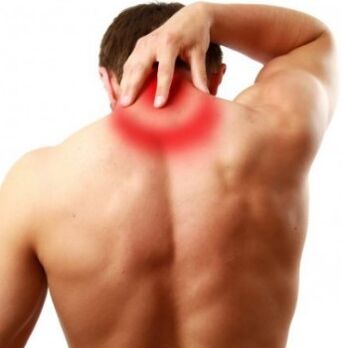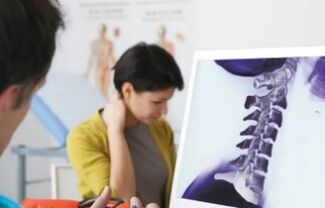Osteochondrosis is a spine disease, characterized by the development of changes in the cartilage of intervertebral disks and reactive processes in the surrounding tissues.
Cervical osteochondrosis spineIt differs in their manifestations of thoracic and lumbar osteochondrose.Symptoms of cervical osteochondrosis are connected to the anatomical characteristics of the cervix spine.The dimensions of the vertebral cervical region are less than the size of the other departments.The cervical department is constantly experiencing a burden, holding his head, and at the same time it is very mobility.

Causes of osteochondrose
Causes of disease development, above all, due to age - regulated aging of the body and the development of bone and cartilage destruction.The following causes of osteochondrose can be called:
- Breach of position,
- Reduction of motor activity as a result of a seating lifestyle,
- Surplus weight, which is the result of metabolic disorders, has a load on intervertebral discs,
- hereditary factor,
- Long-term physical activity,
- Bine abnormalities.
Unique physical activity, proper nutrition and a healthy lifestyle significantly reduce the likelihood of developing this disease, and also reduce the effect on the overall well-being.
Symptoms of cervical spine osteochondrosis
Cervical osteochondrose events differ from symptoms in another spine.This is due to the fact that cervical spine have a different structure and are very close.Therefore, any displaced manifested the pain.In addition, the nervous package and arteries often fit in the neck of the spine.
Cervical osteochondrosis of spineIt is manifested by the following symptoms:
- Sensations of pain - pain can be felt in different parts of the body.This is due to the fact that secures the nerve endings and muscles of the appropriate part of the body.
- Weakness in the upper limbs - manifests due to pushing nerve endings responsible for motorcycle activities.
- Difficulties in turning their heads, the appearance of the vertebral crisis in the cervical region - created due to changes in the structure of the intervertebral disk, the appearance of bone formations.
- Low-hand sensitivity.
- Weakness and dizziness appear due to the artery push, which ensures blood and nutrition into the brain.
- Reducing hearing and vision - appears in the last phase of the disease, when blood circulation in cerebellum is disturbed.
Signs Department of Grlić uterine osteochondrosis
- Rine syndrome - characterized by tinging a nerve beam in the neck.They manifest themselves with heavy pain that can be felt on your shoulders, a spatula.
- Spine syndrome - manifests the strongest headaches, hurts in temples and the back of the head.
- Reflex syndrome - characterized by strong pain in the cervical region, which can be intensified with any head movement.The pain can be moved to the shoulder and on the chest.
- Cardinal syndrome - reminds of the attack of angina pectoris, which is extremely difficult to determine.
Development level of cervical spine Osteochondrosis
As it develops, the disease passes several phases.Each phase has its own characteristics and features certain functions.
- 1. Phase.Bone vertebra tissues gradually begins to assemble.Symptoms of the disease are not noticeable.And very often patients simply do not notice them, but join fatigue and pain with excessive work and stress.
- 2. Phase.Height, the disc starts down, cracks appear on it.The patient is experiencing constant pain, weakness, facial stiffness.
- 3. Phase.Drops of disks begin to form, cervacials and muscles were damaged.There are complaints for dizziness, hurts in the back of your head.
- Fourth phase.The bony tissue that protects the spine of excess load begins to grow, as a result of the nervous endings.There is stiffness in motion, neighboring compounds are damaged.
Dangers of cervical osteochondrose
A large number of nerves and arteries are located in the cervical area, which provide the brain.In the event of a violation of their work, the brain will not get enough nutrition for normal functioning.This situation may violate the person's engine activity, cause the pain in the limbs, as well as the loss of coordination.
In an advanced stage of osteochondrose, ischemia, stroke and many other diseases that are dangerous to human life can develop.
Therefore, when any symptoms associated with this disease occur, it is recommended to seek medical attention.
The diagnosis of the spine of cervix
The following types of diagnostics are used to test the spine disease:
- The X -Ray image is an inefficient way to diagnose this disease,
- MRI (magnetic resonance) shows bone structures, formed disk and their size,
- CT (calculated tomography) is inefficient in relation to MRI, because with the help of this diagnostic method, it is difficult to determine the size of Hernia,
- The ultrasonic duplex scan is used when the overall blood flow is disrupted.This review shows the existing blood flow rate, as well as the presence of obstacles on the road.
Treatment of cervical spine Osteochondrosis

The treatment of cervical osteochondrose spine should be performed in a complex depending on the situation.A positive effect can be achieved thanks to a comprehensive and individual approach involving drug treatment, physiological procedure, physiotherapy exercises, massages and traditional medicine.
During the deterioration period, the treatment of cervical osteochondrose of the spine is focused on increasing blood circulation, in releasing against muscle cramps.In this case, agents who improve blood flow, anti-inflammatory and hospital and the vitamin complex are prescribed.
Media Physical Education for Osteochondrose of the Cervical Region
Therapeutic gymnastics provides visible results and is less dangerous in the recovery phase.The principle of operation of the exercises of physiotherapy is the restoration of blood flow on damaged parts of the body.Performing exercises physiotherapy exercises, the patient should not feel pain and inconvenience.
A set of cervical spine exercises is designed to strengthen the neck muscles, and also acts as preventing cervical osteochondrose.
Massage for osteochondrosis of cervix
The massage is done to strengthen the tone in the muscles and relieves the pain.Depending on the disease development phase, various massage methods are made.Classic massage techniques include:
- Setup - This technique consists in the effect on the surface layers of the skin.The massage begins with the surrounding environment and continues to the clavicle and armpits.
- Solid - in this case, the effect during the massage occurs in the deeper layers of the skin.The bashing neck with your thumb and forefinger performs movements for taking the skin, which resembles a grip.
- Rubbing - performed with the aim of heating and relaxing the skin to improve blood supply around the spine of the cervix.
- Moving - has special restrictions, because it affects deep fake fabrics.If this technique is improperly executed, the patient may be harmful.
In cases where the patient's sense of pain occurs only on one side, the massage should begin to perform from a healthy part of the door, gradually moves into that part of the cervical region in which pain appears.
Massage can also be performed at home and in the medical institution.However, during your application, you should be very careful so that you do not cause disease exacerbation or do not work above.
Prevention of cervical osteochondrose
To prevent the occurrence and development of the disease, it is recommended to comply with simple rules:
- Take a healthy lifestyle, make physical exercises, visit the pool regularly;
- Diversification of food diet rich in magnesium and calcium;
- In case of sitting work, it is necessary to heat several times a day;
- To sleep, you should choose an orthopedic mattress and a comfortable pillow.






















